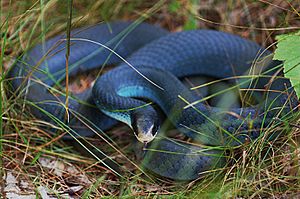Blue racer facts for kids
Quick facts for kids Coluber constrictor foxii |
|
|---|---|
 |
|
| A blue racer snake coiled up | |
| Scientific classification |
|
| Kingdom: | Animalia |
| Phylum: | Chordata |
| Class: | Reptilia |
| Order: | Squamata |
| Suborder: | Serpentes |
| Family: | Colubridae |
| Genus: | Coluber |
| Species: | |
| Subspecies: |
C. c. foxii
|
| Trinomial name | |
| Coluber constrictor foxii (Baird & Girard, 1853)
|
|
| Synonyms | |
The blue racer (scientific name: Coluber constrictor foxii) is a type of snake. It is a subspecies of the Coluber constrictor, which is also known as the eastern racer. These snakes are not venomous, meaning they are not poisonous. They belong to a family of snakes called colubrids.
Contents
What is the Blue Racer Snake?
The blue racer is a fast and active snake. It gets its name from its amazing speed. It can move very quickly across the ground. This helps it catch its food and escape from danger.
Where Do Blue Racers Live?
Blue racers are found in parts of North America. They live in the Great Lakes region, including parts of Canada (like Ontario) and the United States. You can also find them in some areas of the Eastern United States. They like open areas. These include grasslands, fields, and forest edges. They also live in sandy areas near lakes.
What Do Blue Racers Look Like?
As their name suggests, blue racers often have a bluish-gray color. Sometimes they can look more greenish-blue. Young blue racers look different from adults. Baby blue racers are usually gray or tan. They have dark blotches or spots on their bodies. As they grow older, these spots fade away. Their color changes to the solid blue or gray of an adult. Adult blue racers can grow quite long. They can reach lengths of 3 to 6 feet (about 1 to 1.8 meters). They have smooth scales. They also have large eyes.
What Do Blue Racers Eat?
Blue racers are carnivores, which means they eat meat. They are very good hunters. They use their speed and good eyesight to find food. Their diet includes many different small animals.
- Small rodents like mice and voles
- Frogs and other amphibians
- Lizards and other small reptiles
- Birds and their eggs
- Large insects like grasshoppers
They do not constrict their prey like some other snakes. Instead, they usually overpower their prey. They might pin it down or swallow it alive.
How Do Blue Racers Behave?
Blue racers are active during the day. This means they are diurnal. They are often seen basking in the sun. This helps them warm up their bodies. They are also known for being shy. If they feel threatened, they will try to escape quickly. They might also vibrate their tail. This can sound like a rattlesnake in dry leaves. This behavior helps scare away predators. In colder months, blue racers will hibernate. They find safe places underground to stay warm. These places are called hibernacula. They might share these spots with other snakes.
Are Blue Racers in Danger?
In some areas, the blue racer snake is considered an endangered species. This means their numbers are decreasing. There are a few reasons for this decline.
- Habitat loss: Their natural homes are being destroyed. This happens when land is used for buildings or farms.
- Roads: Many snakes are hit by cars when crossing roads.
- Pesticides: Chemicals used on farms can harm the snakes. They can also harm the animals the snakes eat.
Conservation efforts are important to protect blue racers. These efforts include protecting their habitats. They also involve educating people about these amazing snakes.

